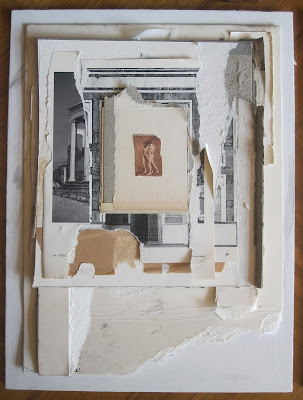Zurbaran. The Sudarium of Saint Veronica
(1658-61)
The miraculous impression of Christ's image on the sudarium (sweat cloth) or veil that St.Veronica, by tradition, wiped his face on during the passion is the original Christian 'icon', image or sign that stands as a substitute for the reality it represents through a likeness or analogy. Although not mentioned in the gospels the event itself is represented in the traditional pictorial scheme as the sixth of the fourteen Stations of the Cross.
Like the Turin Shroud, supposedly the cloth that the body of the dead Christ was wrapped in to be placed in the tomb, it seems strangely to anticipate the process of printmaking or indeed the much later science of darkroom photography with a transfer of an impression from one surface to another to create an image or likeness.
Zurbaran's painting ( he made about 14 versions during his life) is an image on a linen surface representing an image on another linen surface and is therefor as much an intellectual contemplation on the nature of image making, both human and divine as it is an act of pious devotion.
Both Christ, 'the word made flesh' and Zurbaran appear to be 'artists' able to conjure or create 'miraculous' images on surfaces that are catalysts for powerful emotions in the mind of the devotee. Christ's incarnation in a physical human body and the image of Christ 'incarnated' in painting have a miraculous 'materiality' and 'presence' in the absence of the actual body. Zurbaran, through the miracle or magic of painting, brings the tension between material and immaterial, physical and spiritual worlds into a harmonious yet challenging synthesis, paradoxically re-incarnating the 'real' world in a 'true' representation, by fooling the eye with clever trick or tromp l' oeil.
The Sudarium of St Veronica (1658-61) (Oil on canvas 104 x 84 cm) Museo de Bellas Artes Bilbao.
Almost exactly contemporary with Zurbaran's painting of the sudarium is Cornelis Norbertus Gijbrechts' 'The Reverse Side of a Painting' from 1670
 |
Cornelis Norbertus Gijbrechts. 'The Reverse Side of a Painting' 1670 |
Hanneke Grootenboer has this to say in Chapter One 'The Invisibility of Depth' on page 58 of her book The Rhetoric of Perspective - Realism and Illusionism in Seventeenth Century Dutch Still-Life Painting'
' The trompe l'oeil pretends to be a painted surface behind which lies neither truth nor meaning, but solely the back of the canvas. If indeed, this is the only thing that trompe l'oeil painting may tell us, then Cornelius Gijbrechts has reached the ultimate limit of painting as such in his work The Reverse Side of a Painting 1670. This work presents everything that constitutes a painting: we see the wooden stretcher, held together by several nails that cast small shadows on the construction. The stretcher frames the back of a painted canvas, its frayed edges visible between the wooden slats. But where is the image? Literally turning its back on paitning as well as on its viewer, this canvas tends to be its negative, a clear instance of Baudrillard's statement that a trompe l'oeil is an anti-painting. If we follow our inclination to turn this canvas around in order to see what is represented on its front side, its hock effect would reside less in the deception, and more in the discovery that there is nothing there to see. Nothing, except for the same image front and back'
























,_Kunst-_und_Rarita%CC%88tenkammer_(1636).jpg)











